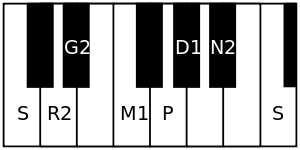Anandabhairavi
| Carnatic music |
|---|
Tanjavur-style Tambura |
| Concepts |
| Compositions |
| Instruments |
|
Anandabhairavi or Ananda Bhairavi (pronounced ānandabhairavi) is a very old melodious rāgam (musical scale) of Carnatic music (South Indian classical music) and Yakshagana music. This rāgam also used in Indian traditional and regional musics. Ānandam (Sanskrit) means happiness and the rāgam brings a happy mood to the listener.
It is a janya rāgam (derived scale) of the 20th Melakarta rāgam Natabhairavi,[1][2] although some suggest that it is janya of 22nd melakarta Kharaharapriya.
Structure and Lakshana

Its ārohaṇa-avarohaṇa structure is as follows (see swaras in Carnatic music for details on the notations used):
(chathusruthi rishabham, sadharana gandharam, shuddha madhyamam, Chatusruthi dhaivatham, kaisiki nishadham)
It is a sampoorna rāgam – rāgam having all 7 swarams, but it is not a melakarta rāgam, as it has vakra prayogam (zig-zag notes in scale) and uses anya swaram (external note) in comparison with its parent rāgam. The anya swaram is the usage of chathusruthi dhaivatham (D2) in some phrases of the rāgam.[1]
Anandabhairavi ragam is also a bhashanga rāgam, since it uses more than one anya swaram. Anya swaram of a rāgam is the swaram which does not belong to the arohana or avarohana of its melakarta (parent rāgam), but it is sung in prayogams (phrases used in raga alapana, kalpanaswarams).
Swara phrases
The three anya swarams of Anandabhairavi are antara gandharam (G3), chatusruti dhaivatam (D2) and kakali nishadham (N3).[1] All of these anya swaras occur only in prayogas (not in arohana avarohana). "G3" occurs in "ma pa ma ga ga ma", and "D2" occurs in "ga ma pa da". Generally "N3" is not sung these days.
It is said that Tyagaraja and Muthuswami Dikshitar do not use any of the anya swarams in their compositions.
Anandabhairavi also has unique swara patterns both in manodharma (impromptu improvisations by performer) and in its compositions. The popular patterns are SGGM, SP, and SGMP. The musician isn't allowed to stay long on nishadam, this characteristic distinguishes it from Reetigowla. Few allied ragas (similar) to this are Reetigowla and Huseni.
Popular Compositions
Anandabhairavi is one of the favourite ragams of Syama Sastri. He is said to have made this a popular rāgam and also to have given the present form for this rāgam.[1] More or less Anandabhairavi's synonym is "Marivere gati" by Syama Sastri. In "Mariverae" and in "O jagadhamba" Syama Sastri uses the anya swara "ga(2)".A very life changing incident is said to have happened in Thyagaraja's life. Once he is said to have attended a Kuchipudi bhagavata artists (gypsy group's) dance-drama recital,a ballad between mythological characters Radha and Krishna, and he is said to have highly praised their performance, especially a particular song Mathura Nagarilo,which was again set in Ananda Bhairavi.Thyagaraja wanting to acknowledge them offered to give them a gift, of anything that they may desire, that he could possibly give. After much thought they demanded him the Ragam Ananda Bhairavi itself as a gift ( meaning that he would accept to never sing in that ragam ever again in his life),so that when someone in the near future spoke of Thyagaraja or Ananda Bhairavi's legacy they would also remember the Kuchipudi dancers too.
- Pongolalanudutiha Yadukulottunga by Purandaradasa
- Marivere Gati and O jagadhamba by Syama Sastri
- Maanasa guruguha, Dandayudhapanim, Kamalamba Samrakshatu, Anandeswarena and Thyagaraja yoga vaibhavam by Muthuswami Dikshitar
- Samaganapriye by Periyasaamy Thooran
- Nike Teliyaka in Adi thalam by Thyagaraja
- Paluke Bangaru by Ramadas
- iTTi muddulADibAluDeDavADe by Annamacharya
- kaMTi SukravAramu by Annamacharya
- rAmabhadra raghuvIra by Annamacharya
- Poo Mel Valarum Annaiye by Mazhavai Chidambara Bharathi